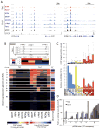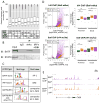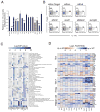A validated regulatory network for Th17 cell specification
- PMID: 23021777
- PMCID: PMC3503487
- DOI: 10.1016/j.cell.2012.09.016
A validated regulatory network for Th17 cell specification
Erratum in
-
A Validated Regulatory Network for Th17 Cell Specification.Cell. 2025 Sep 23:S0092-8674(25)01083-9. doi: 10.1016/j.cell.2025.09.015. Online ahead of print. Cell. 2025. PMID: 40992377 No abstract available.
Abstract
Th17 cells have critical roles in mucosal defense and are major contributors to inflammatory disease. Their differentiation requires the nuclear hormone receptor RORγt working with multiple other essential transcription factors (TFs). We have used an iterative systems approach, combining genome-wide TF occupancy, expression profiling of TF mutants, and expression time series to delineate the Th17 global transcriptional regulatory network. We find that cooperatively bound BATF and IRF4 contribute to initial chromatin accessibility and, with STAT3, initiate a transcriptional program that is then globally tuned by the lineage-specifying TF RORγt, which plays a focal deterministic role at key loci. Integration of multiple data sets allowed inference of an accurate predictive model that we computationally and experimentally validated, identifying multiple new Th17 regulators, including Fosl2, a key determinant of cellular plasticity. This interconnected network can be used to investigate new therapeutic approaches to manipulate Th17 functions in the setting of inflammatory disease.
Copyright © 2012 Elsevier Inc. All rights reserved.
Figures







Comment in
-
Targeting Th17 cells in immune diseases.Cell Res. 2014 Aug;24(8):901-3. doi: 10.1038/cr.2014.92. Epub 2014 Jul 15. Cell Res. 2014. PMID: 25022899 Free PMC article.
References
-
- Bonneau R, Facciotti MT, Reiss DJ, Schmid AK, Pan M, Kaur A, Thorsson V, Shannon P, Johnson MH, Bare JC, et al. A predictive model for transcriptional control of physiology in a free living cell. Cell. 2007;131:1354–1365. - PubMed
-
- Brustle A, Heink S, Huber M, Rosenplanter C, Stadelmann C, Yu P, Arpaia E, Mak TW, Kamradt T, Lohoff M. The development of inflammatory T(H)-17 cells requires interferon-regulatory factor 4. Nat Immunol. 2007;8:958–966. - PubMed
Publication types
MeSH terms
Substances
Associated data
- Actions
Grants and funding
LinkOut - more resources
Full Text Sources
Other Literature Sources
Molecular Biology Databases
Miscellaneous

